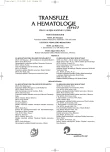New approaches to diagnosis and treatment of iron overload
Některé nové poznatky v diagnostice a léčbě stavů s přetížením železem
Přetížení železem může vést k závažnému postižením orgánů hromadícím se toxickým železem. Nejčastější příčinou přetížení železem je jeho nadbytečný přívod, jako je tomu při dědičné hemochromatóze a u nemocných s anémií s hyperplastickou inefektivní erytropoézou dependentních na podávání transfuzí erytrocytů (thalasemie, myelodysplastický syndrom). V diagnostice nadbytku železa se uplatňují laboratorní metody (hladina feritinu v séru, saturace transferinu), invazivní metody (jaterní biopsie) a neinvazivní metody kvantifikující množství železa v játrech či myokardu (nukleární magnetická resonance). Klinické příznaky povětšinou odrážejí hromadění nadbytečného železa v orgánech. Základem léčby přetížení železem je včasné podávání dostatečně vysoké dávky chelátoru po dostatečně dlouhou dobu. V současné době se v léčbě kromě desferioxaminu uplatňují i perorální chelátory, jejichž účinek je srovnatelný s účinkem desferioxaminu. Jedná se zejména o deferiprone a v poslední době též o deferasirox.
Klíčová slova:
přetížení železem, diagnostika, léčba, chelatace, desferioxamin, deferiprone
Authors:
J. Čermák
Authors‘ workplace:
Ústav hematologie a krevní transfuze, Praha
Published in:
Transfuze Hematol. dnes,12, 2006, No. 3, p. 140-144.
Category:
Comprehensive Reports, Original Papers, Case Reports
Overview
Iron overload may lead to serious organ damage caused by a surplus of toxic iron. Iron overload results in most of cases as a consequence of increased influx of iron in the body, eg. in patients with hereditary hemochromatosis or in red blood cell transfusion dependent patients with anaemias with hyperplastic ineffective erythropoiesis (thalassemia, myelodysplastic syndrome). Diagnosis of iron overload is based on laboratory methods (serum ferritin, transferrin saturation), invasive methods (liver biopsy) or on non-invasive quantification of iron amount in liver or heart (magnetic resonance imaging). Clinical symptoms usually reflect the degree of organ iron load. The treatment of iron overload is based on early administration of sufficient dosis of chelating agents for prolonged time period. At present time, new oral iron chelatrors (deferiprone, deferasirox) with efficency comparable to desferioxamine are available as an alternative treatment of iron overload.
Key words:
iron overload, diagnosis, treatment, chelation, desferioxamine, deferiprone
Labels
Haematology Internal medicine Clinical oncologyArticle was published in
Transfusion and Haematology Today

2006 Issue 3
- Cost Effectiveness of FVIII Substitution Versus Non-Factor Therapy for Hemophilia A
- Vascular Disease in the Gradually Aging Population of Hemophiliacs: An Underestimated Problem?
- Prognostic Significance of Subclinical Joint Changes on MRI in Hemophilia
- Immunotolerance is still the goal of management of hemophilia A with inhibitor in the era of non-factor therapy
- Minimum and Optimal Factor Levels in Physically Active Hemophiliacs
Most read in this issue
- Splenectomy in diagnostics and treatment of hematological disorders: A single-center indications, complications and results
- Plasma concentrations of cytokines and co-stimulatory molecules (interleukins IL-2, IL-4, IL-5, IL-6, IL-8, IL-10, IL-13, TNF-α, TGFβ1, sCD23, sCD40L and IL-6 receptor) in healthy blood donors
- The standardization of a biochemical laboratory determination of multiple myeloma
- New approaches to diagnosis and treatment of iron overload
